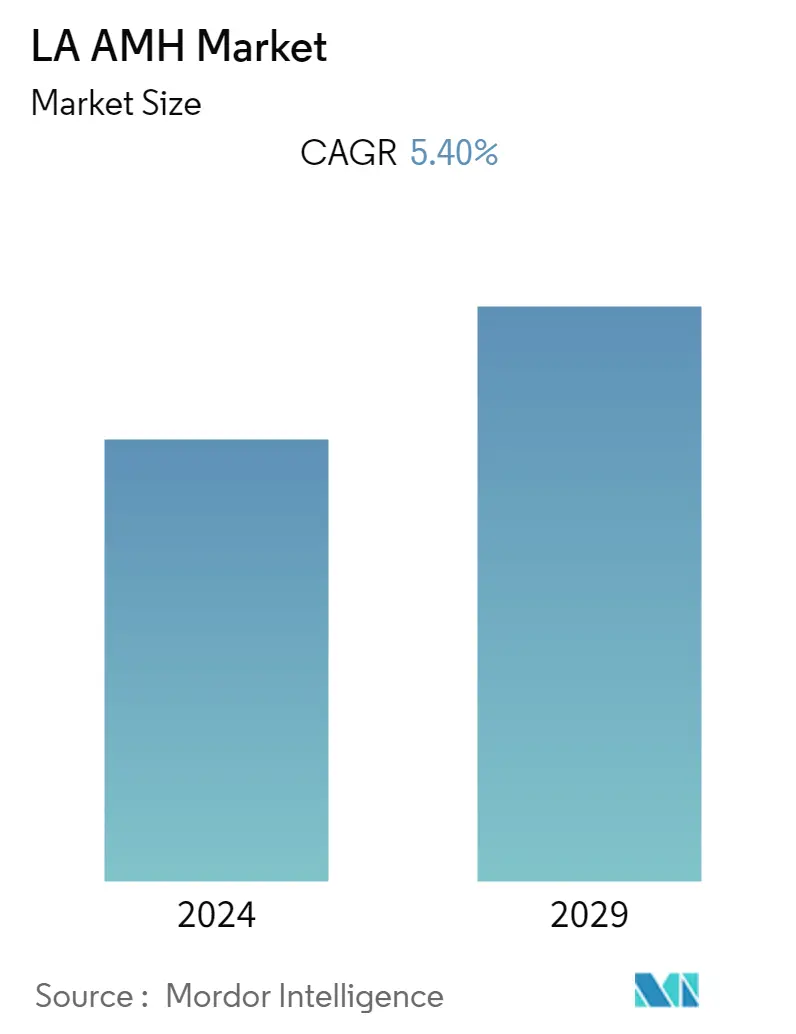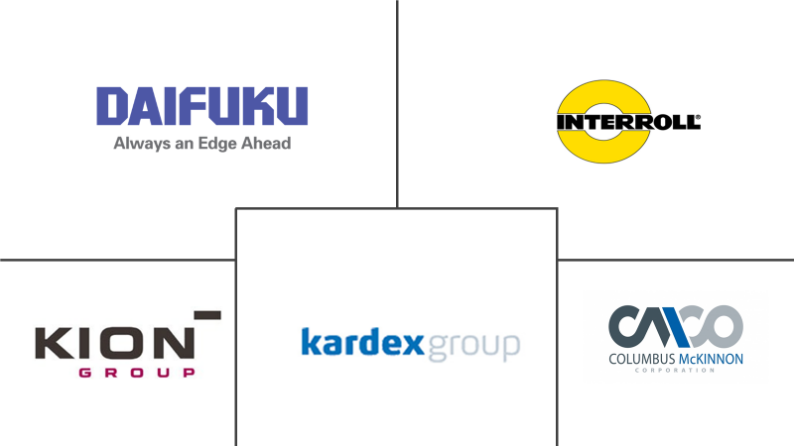Market Size of LA AMH Industry

| Study Period | 2019 - 2029 |
| Base Year For Estimation | 2023 |
| Forecast Data Period | 2024 - 2029 |
| Historical Data Period | 2019 - 2022 |
| CAGR | 5.40 % |
| Market Concentration | Medium |
Major Players
*Disclaimer: Major Players sorted in no particular order |
Latin America AMH Market Analysis
The Latin America automated material handling market is expected to grow at a CAGR of 5.4% over the forecast period (2021-2026).
- Latin America is economically expanding, is resourceful, and demographically buoyant. Thus, it is a promising market for automation. The burgeoning population of the upper and middle classes in the region is expected to increase automation adoption. However, primarily due to a rapid increase in labor costs, many business models are likely to change.
- The delivery of a return on investment (ROI) from automation is generally fast in Brazil. ROI of 2-4 years is achievable, which is less as compared to other emerging countries. Decreasing operating costs and radically reducing inefficiencies in the processes by implementing automation are playing major roles in the adoption of automation in the country. Picking and pallet handling are the major areas in which many gains can be achieved with the help of automation technologies.
- The region has witnessed an increasing investment in e-commerce. For instance, the region witnessed the establishment of several new distribution centers in Argentina, Brazil, and Mexico post the investment of USD 750 million and USD 100 million by PayPal and Dragoneer in Argentina-based e-commerce giant, MercadoLibre.
- Besides, Brazil is expected to account for the most considerable retail e-commerce revenue in the region, with a value of USD 17.35 billion, at a slightly constant rate over the forecast period.
- The Covid-19 pandemic has ushered several companies to incorporate Material Handling products to minimize human interaction on the floor. Thus, to tap into this demand, in July 2021, Eastman Machine Company appointed CMP Trading of São José dos Campos (São Paulo), Brazil, to represent its line of automated cutting systems, material handling equipment, and design software.
Latin America AMH Industry Segmentation
Automated material handling equipment eliminates the need for human interference in a material handling process. Continuous rise in demand for automation with the advent of technologies such as robotics, wireless technologies, and driverless vehicles in different industries like food and beverages, retail, general manufacturing, pharmaceuticals, and post & parcel has revolutionized the adoption of automated material handling equipment. Type of equipment such as AS/RS, AGV, conveyor, palletizer, and sortation systems are considered under the scope of the market.
| By Product Type | |
| Hardware | |
| Software | |
| Services |
| By Equipment Type | |||||||||||
| |||||||||||
| |||||||||||
| |||||||||||
| |||||||||||
| Sortation System |
| By End-user Vertical | |
| Airport | |
| Automotive | |
| Food and Beverage | |
| Retail/Warehousing/ Distribution Centers/Logistic Centers | |
| General Manufacturing | |
| Pharmaceuticals | |
| Post and Parcel | |
| Other End Users |
| By Country | |
| Brazil | |
| Argentina | |
| Mexico | |
| Colombia | |
| Peru | |
| Chile | |
| Rest of Latin America |
LA AMH Market Size Summary
The Latin America automated material handling market is experiencing promising growth, driven by economic expansion, resource availability, and a growing upper and middle class population. This demographic shift is fostering increased adoption of automation technologies, particularly in Brazil, where rapid labor cost increases are prompting changes in business models. The region's investment in e-commerce is also significant, with countries like Brazil, Argentina, and Mexico seeing the establishment of new distribution centers. The Covid-19 pandemic has further accelerated the adoption of automated material handling systems to reduce human interaction, as evidenced by companies like Eastman Machine Company expanding their presence in Brazil. Mexico's robust automotive and aerospace sectors are benefiting from advanced automation, providing a competitive edge and promoting job growth through increased investment in robotics and automation technologies.
The food and beverage industry is a major economic contributor in Latin America, with Brazil, Argentina, Mexico, Colombia, Peru, and Chile playing significant roles in various segments. The demand for automated material handling systems is driven by the industry's growth and the penetration of automation service providers. In Mexico, the trend towards hybrid automation is notable, allowing existing workers to upskill with minimal training due to a scarcity of skilled labor. This has led to a high demand for collaborative robots and semi-automation solutions, particularly in seafood processing. The market is characterized by fragmentation and moderate competition, with companies focusing on product launches, research and development, and strategic partnerships to maintain their competitive edge. Notable collaborations, such as those between ZKW Group and Swisslog, and Durr's modernization of the Mercedes-Benz bus chassis production line, highlight the ongoing advancements and investments in automated material handling systems across the region.
LA AMH Market Size - Table of Contents
-
1. MARKET DYNAMICS
-
1.1 Market Overview
-
1.2 Assessment of the Impact of COVID-19 on the Market
-
1.3 Market Drivers
-
1.3.1 Rising E-commerce Industry
-
1.3.2 Industry 4.0 investments driving the demand for automation and material handling
-
-
1.4 Market Restraints
-
1.4.1 The Staffing Challenge
-
1.4.2 High Initial Costs
-
-
1.5 Industry Value Chain Analysis
-
1.6 Industry Attractiveness - Porter's Five Forces Analysis
-
1.6.1 Threat of New Entrants
-
1.6.2 Bargaining Power of Buyers
-
1.6.3 Bargaining Power of Suppliers
-
1.6.4 Threat of Substitute Products
-
1.6.5 Intensity of Competitive Rivalry
-
-
-
2. MARKET SEGMENTATION
-
2.1 By Product Type
-
2.1.1 Hardware
-
2.1.2 Software
-
2.1.3 Services
-
-
2.2 By Equipment Type
-
2.2.1 Mobile Robots
-
2.2.1.1 Automated Guided Vehicle (AGV)
-
2.2.1.1.1 Automated Forklift
-
2.2.1.1.2 Automated Tow/Tractor/Tug
-
2.2.1.1.3 Unit Load
-
2.2.1.1.4 Assembly Line
-
2.2.1.1.5 Special Purpose
-
-
2.2.1.2 Autonomous Mobile Robots (AMR)
-
2.2.1.3 Laser Guided Vehicle
-
-
2.2.2 Automated Storage and Retrieval System (ASRS)
-
2.2.2.1 Fixed Aisle (Stacker Crane + Shuttle System)
-
2.2.2.2 Carousel (Horizontal Carousel + Vertical Carousel)
-
2.2.2.3 Vertical Lift Module
-
-
2.2.3 Automated Conveyor
-
2.2.3.1 Belt
-
2.2.3.2 Roller
-
2.2.3.3 Pallet
-
2.2.3.4 Overhead
-
-
2.2.4 Palletizer
-
2.2.4.1 Conventional (High Level + Low Level)
-
2.2.4.2 Robotic
-
-
2.2.5 Sortation System
-
-
2.3 By End-user Vertical
-
2.3.1 Airport
-
2.3.2 Automotive
-
2.3.3 Food and Beverage
-
2.3.4 Retail/Warehousing/ Distribution Centers/Logistic Centers
-
2.3.5 General Manufacturing
-
2.3.6 Pharmaceuticals
-
2.3.7 Post and Parcel
-
2.3.8 Other End Users
-
-
2.4 By Country
-
2.4.1 Brazil
-
2.4.2 Argentina
-
2.4.3 Mexico
-
2.4.4 Colombia
-
2.4.5 Peru
-
2.4.6 Chile
-
2.4.7 Rest of Latin America
-
-
LA AMH Market Size FAQs
What is the current LA AMH Market size?
The LA AMH Market is projected to register a CAGR of 5.40% during the forecast period (2024-2029)
Who are the key players in LA AMH Market?
Daifuku Co. Ltd., Interroll Holding AG, Kardex Group, KION Group and Columbus McKinnon Corporation are the major companies operating in the LA AMH Market.

